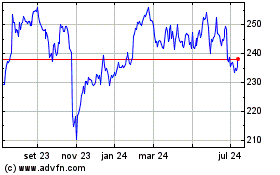ISM Service Index Disappoints - Analyst Blog
03 Novembro 2011 - 11:39AM
Zacks
The Institute for Supply Management’s Non-Manufacturing, or
Service, survey fell in October to 52.9 from 53.0 in September. It
was worse than the consensus expectation that it would rise to
53.8.
It is not a great reading in an absolute sense. Over the last year
it has averaged 55.3, and it hit a high or 59.7 in February. Still,
it is strong evidence that we are not (yet) in a recession. Like
its venerable brother, the Manufacturing survey, this is a “magic
50” index where any reading above 50 indicates that the economy is
expanding and anything below 50 represents an economic contraction.
Thus, this means that the Service side of the economy, which is far
larger than the manufacturing side, is still growing. However, the
rate of growth slowed slightly in October relative to
September.
This makes it 23 straight months that it has been over the "magic
50" level. On Tuesday, the ISM manufacturing also showed slow but
positive growth. It fell to 50.8 from 51.6. It, too, was weaker
than the expected level of 52.1.
Behind the Headline Number
Like the Manufacturing survey, this index is made up of ten
sub-indexes that roughly correspond to the manufacturing
sub-indexes. Six of the sub-indexes fell while four increased on
the service side this month. Seven are above the "magic 50" level.
The performance of the more important sub-indexes were mixed, but
on balance were bad news (relative to October).
The most important measure of current business activity is, well,
the business activity sub-index. It fell 3.3 points this month, to
53.8. That is not an awful level, but the decline is disconcerting.
Nine industries reported higher business activity and five reported
a slowdown in activity. Thus business activity in October, while
higher than in September is starting to decelerate.
Results by Sub-Index
The most important index for the very short-term future is the
backlog of orders index. That fell by 5.5 points to 47.0. The
decline is not welcome news. In the Manufacturing report, the
backlog sub index rose by 6.0 points, but from an awful level and
still indicated contraction with a reading of 47.5. It is not a
very good sign for the immediate future to have order backlogs
shrinking on both the Manufacturing and the Service sectors.
There were just three service industries reporting an increase in
backlog, and seven with a decline. A falling backlog is a good
indication that activity is going to drop in the near future. As
businesses work off their existing backlog of orders, they need to
replace them with new orders.
There the news was also bad, with a drop of 4.1 points to 52.4.
That is not an awful level, but the sharp drop for the month is
hard to see as a positive. Still, new orders have been expanding
now for 27 straight months. There were ten industries reporting
higher new orders and five reporting a decline.
The employment sub-index is also very important, especially with
unemployment running at 9.1%. The 4.6 point increase in this
sub-index is the most important silver lining in this report. It is
now at a level of 53.3, and back over the magic-50 level after
dipping below it last month, which means that
non-manufacturing employment is still growing.
This is consistent with the
ADP (ADP) report we
got yesterday, which showed a 114,000 gain in service sector jobs.
On the manufacturing side, the employment sub-index slipped 0.3
points, but was still solidly in positive territory at 53.5.
Unfortunately that was not confirmed by ADP, which showed a drop of
8,000 manufacturing jobs in October. As FAR more people are
employed on the service side of the economy than in manufacturing,
getting back into positive territory in this sub-index is
important.
Eight service industries reported higher employment while seven
reported trimming payrolls. One thing to keep in mind is that these
are diffusion indexes (the reading is the number of positive
responses, plus one half of negative responses, then some of them
are seasonally adjusted). As such, they measure the number of
companies that are adding or trimming jobs, not the number of jobs
they are creating or losing. Thus it is not exactly an apples to
apples comparison. Still, over time, the ISM employment indexes,
both manufacturing and non-manufacturing, have tended to track
employment well.
Discouraging Report
Overall, this was a discouraging report. It was well below
expectations and the bar was not set all that high. The level is
distinctly mediocre, though not a disaster. It is consistent with a
continuation of the pseudo-recovery, where the economy is
technically growing, but not fast enough for anyone to feel it,
especially the army of the unemployed.
It is unlikely that the economy will slip back into a double-dip
recession if the ISM Service index, and the Manufacturing index are
both above the 50 mark. We are safe for now, but neither is all
that far away from dropping below that level, so it would not take
that much to raise the new recession odds. Three of the four key
sub-indexes showed significant deterioration, but only one,
backlog, is indicating an actual contraction. The employment index
was the one ray of sunshine.
The table below comes from the ISM report and shows the sub-indexes
for the service index, as well as the corresponding sub-indexes on
the manufacturing side.

AUTOMATIC DATA (ADP): Free Stock Analysis Report
Zacks Investment Research
Automatic Data Processing (NASDAQ:ADP)
Gráfico Histórico do Ativo
De Jun 2024 até Jul 2024

Automatic Data Processing (NASDAQ:ADP)
Gráfico Histórico do Ativo
De Jul 2023 até Jul 2024
